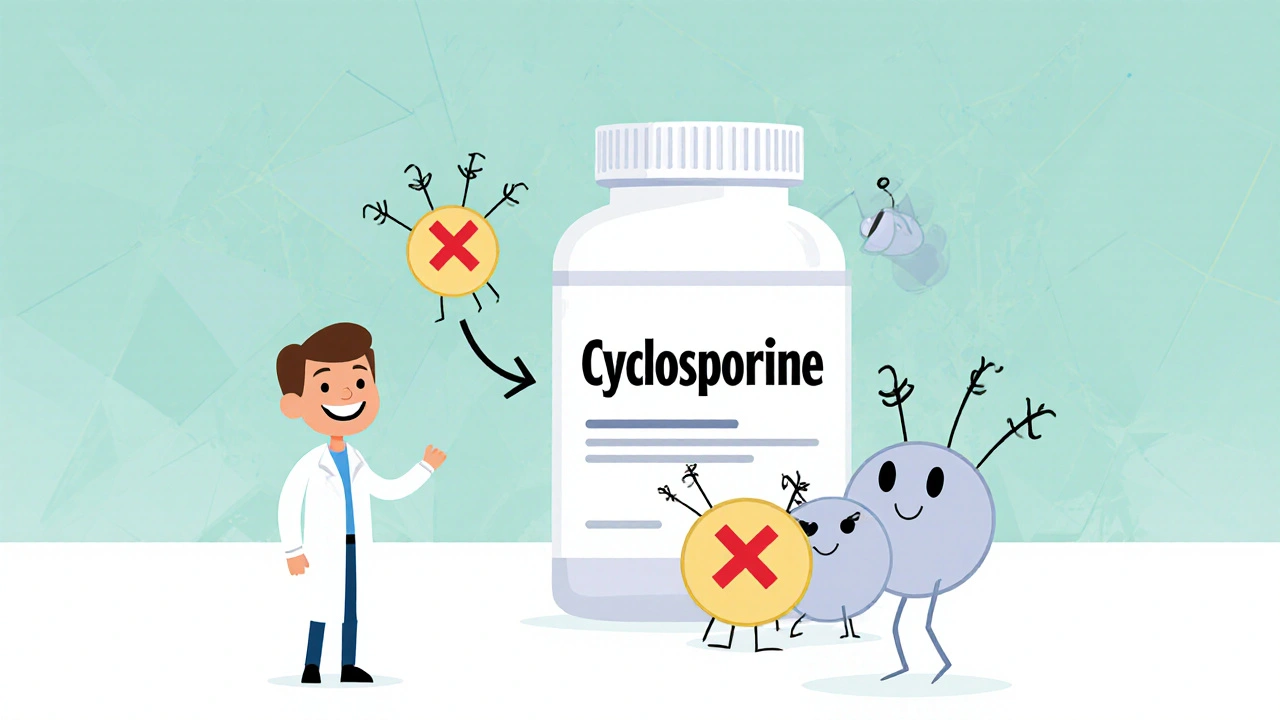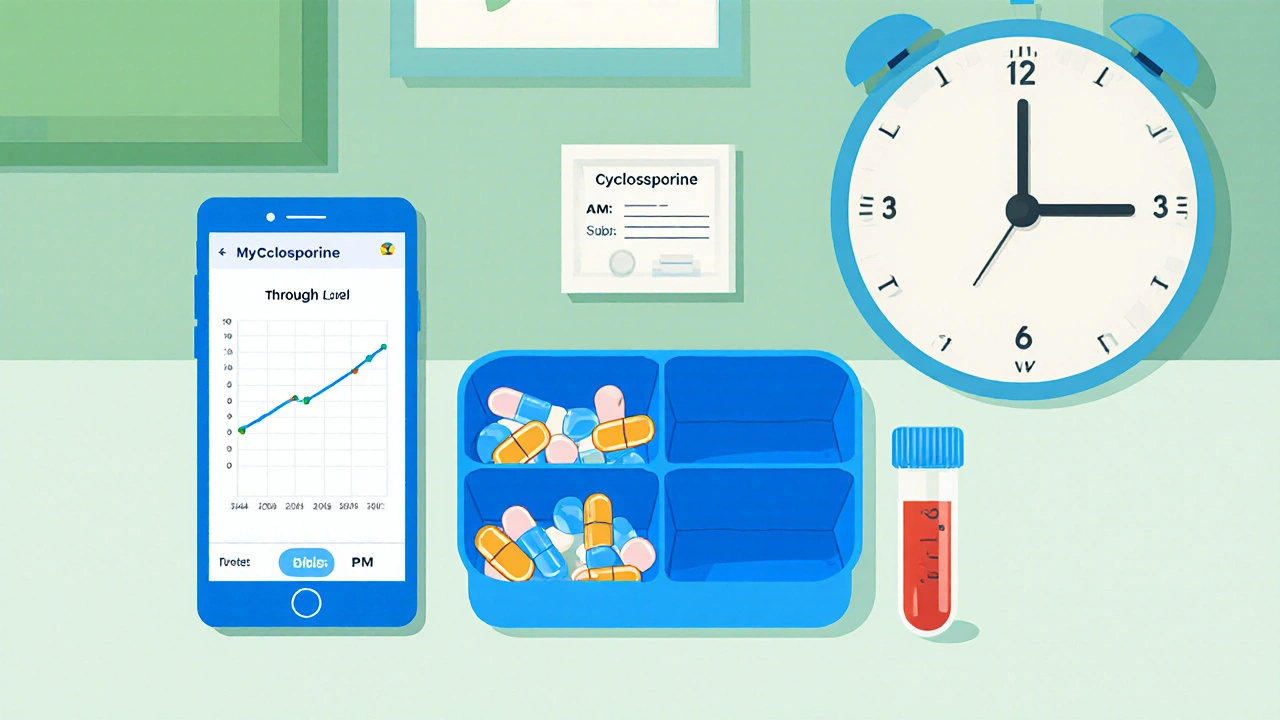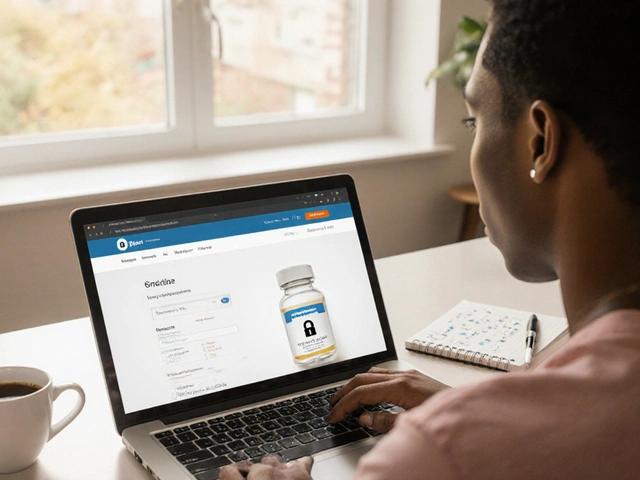
Cyclosporine is a immunosuppressant medication that was first approved in 1983 for preventing organ rejection after transplants. It works by dampening the activity of T‑cells, the part of the immune system that would otherwise attack a newly transplanted organ. Over the decades, doctors have also prescribed it for autoimmune conditions such as rheumatoid arthritis and severe psoriasis. If you’re a patient or caregiver, the drug can feel like a maze-dosing schedules, blood‑test results, side‑effects, and a flood of online information can be overwhelming. This guide untangles the most common questions, points you to trustworthy resources, and offers practical tips to stay on top of therapy.
What Exactly Does Cyclosporine Do?
At its core, cyclosporine blocks the enzyme calcineurin, which stops the production of interleukin‑2, a signal that tells T‑cells to multiply. By curbing this cascade, the drug reduces the immune system’s ability to attack foreign tissue. In the context of an organ transplant, this means the new organ is less likely to be rejected. For rheumatoid arthritis or psoriasis, the same mechanism lowers the inflammatory response that drives joint pain and skin lesions.
Typical Dosage Forms and How to Take Them
Cyclosporine comes in several forms: oral capsules, oral solution, and an intravenous (IV) formulation for hospital use. The most common for long‑term outpatient therapy is the capsule, usually taken twice a day. Dosage is highly individualized-your doctor will calculate it based on body weight, the condition being treated, and the results of regular blood tests that measure the drug’s concentration (often called trough levels).
- Start low, go slow: Initial doses often begin at 2-5 mg/kg per day, split into two doses.
- Adjust based on levels: Target trough levels differ-e.g., 100-200 ng/mL for transplant patients, 150-300 ng/mL for severe psoriasis.
- Take with food: A high‑fat meal can increase absorption, so try to take capsules at the same time each day, preferably with a light snack.
Never double‑dose if you miss a pill; just take the next dose at the scheduled time. Consistency is key because erratic intake can cause spikes in blood levels, raising the risk of kidney toxicity.
Monitoring: Why Blood Tests Matter
Therapeutic drug monitoring (TDM) is the gold standard for safe cyclosporine use. Your lab will draw a blood sample just before your next dose (hence “trough”). The result tells your clinician whether the dose needs tweaking.
- First check is usually 1-2 weeks after starting therapy.
- Subsequent checks occur every 1-3 months, or sooner if you change other meds, develop kidney issues, or notice side‑effects.
- Home‑based apps like MyCyclosporine let you log levels, set reminders, and share data with your healthcare team securely.
Keeping a simple spreadsheet or the app can help you spot trends-e.g., a pattern of rising levels after starting a new antihypertensive.
Common Side Effects and How to Manage Them
Like any powerful drug, cyclosporine has a side‑effect profile you should be ready for. Below is a quick reference table that pairs each frequent complaint with a practical coping tip.
| Side Effect | Typical Onset | Management Tip |
|---|---|---|
| Kidney dysfunction | Weeks to months | Stay hydrated, avoid NSAIDs, monitor creatinine levels. |
| High blood pressure | Weeks | Low‑salt diet, regular BP checks, adjust antihypertensives. |
| Gum hyperplasia (gum overgrowth) | Months | Good oral hygiene, regular dental cleanings, discuss dose reduction. |
| Tremors or shakiness | Days to weeks | Limit caffeine, ensure adequate magnesium intake, report to doctor. |
| Hair loss | Months | Gentle hair care, consider supplements after medical review. |
Always report new or worsening symptoms promptly. Early intervention can prevent permanent damage.
Drug Interactions: What to Watch Out For
Cyclosporine is metabolized by the liver enzyme CYP3A4, so many other drugs can raise or lower its levels.
- Increase levels (risk of toxicity): Ketoconazole, erythromycin, certain calcium‑channel blockers (e.g., diltiazem).
- Decrease levels (risk of rejection or flare‑up): Rifampin, carbamazepine, St. John’s wort.
Keep a master list of all prescription, over‑the‑counter, and herbal products you use. Share it with every clinician you see, from your transplant surgeon to your dentist.
Finding Reliable Resources and Support
Information online can be a double‑edged sword. Here are vetted sources that consistently provide accurate, up‑to‑date guidance:
- National Health Service (NHS) website: Offers clear dosage charts, side‑effect checklists, and links to local clinics.
- U.S. Food and Drug Administration (FDA) drug database: Provides regulatory history, labeling changes, and safety communications.
- American Transplant Foundation: Patient stories, financial aid options, and a forum for transplant recipients.
- Psoriasis Association (UK): Tailored advice for skin‑related issues and dermatologist directories.
- MyCyclosporine app: Free, NHS‑approved tool for tracking levels, side‑effects, and appointment reminders.
Local support groups-whether in‑person at a hospital or virtual on platforms like Facebook-can reduce feelings of isolation. Ask your nurse about a weekly caregiver meetup; many hospitals run them free of charge.

Preparing for Your Doctor’s Appointment
Being organized makes the short visit far more productive. Bring a notebook (or use a note‑taking app) and consider these questions:
- What is my current trough level, and is it within the target range?
- Should my dose be adjusted based on recent labs or new medications?
- Are there any upcoming vaccinations or dental procedures that require special timing?
- What lifestyle changes can help mitigate side effects (e.g., diet, exercise)?
- Do I need any referrals-such as to a nephrologist for kidney monitoring?
Having these items ready helps the clinician focus on decision‑making rather than data‑gathering.
Tips for Caregivers: Keeping the Household Rhythm
Caregivers often juggle medication schedules with work and family life. Here are some low‑effort hacks:
- Use a pill organizer: Choose a 7‑day, twice‑daily compartment to avoid missed doses.
- Set phone alarms labeled “Cyclosporine”: Pair them with a short note about whether it’s the morning or evening dose.
- Batch‑prepare the oral solution: Measure a week's worth at once, store in the fridge, and label each bottle with date and dose.
- Schedule lab draws on the same day as other routine blood work: Saves time and reduces needle fatigue.
- Document side‑effects in a shared Google Sheet: Both patient and caregiver can add notes, making trends visible to the doctor.
Remember to take care of yourself, too-regular breaks and a support network prevent burnout.
When to Seek Immediate Medical Attention
Some warning signs merit a call to your doctor or a trip to the emergency department right away:
- Sudden swelling of the face, lips, or throat (possible allergic reaction).
- Severe headache, vision changes, or seizures (signs of high blood pressure or neurotoxicity).
- Rapid weight gain combined with decreased urine output (possible kidney failure).
- Persistent fever or chills (could indicate infection, especially if you’re immunosuppressed).
Having the emergency contact numbers of your transplant team or rheumatology clinic saved in your phone can shave precious minutes.
Looking Ahead: Future Directions for Cyclosporine Therapy
Research is ongoing to make cyclosporine safer and more convenient. Recent trials are testing once‑daily extended‑release formulations that could replace the twice‑daily schedule. Gene‑editing approaches aim to reduce the need for lifelong immunosuppression altogether. While these are still in experimental stages, staying informed about clinical trial opportunities (often listed on the FDA or NHS trial registries) can give patients early access to cutting‑edge options.
How long do I need to stay on cyclosporine?
For organ‑transplant patients, cyclosporine is usually a lifelong medication to keep the graft alive. In autoimmune diseases, some doctors aim to taper after a year of remission, but the timeline varies widely based on individual response.

Can I take cyclosporine with my blood‑pressure pills?
Many antihypertensives, especially calcium‑channel blockers like diltiazem, are safely co‑prescribed because they’re known to increase cyclosporine levels-a factor doctors use when adjusting doses. Always list all medications for your prescriber so they can fine‑tune the regimen.
Is it safe to travel with cyclosporine?
Yes, but plan ahead. Bring a copy of your prescription, keep medication in original packaging, and carry a letter from your doctor for customs. Schedule a blood‑test before departure if you’re crossing time zones, as dosing times may shift.
What foods should I avoid?
High‑potassium foods (bananas, tomatoes) can stress kidneys already under cyclosporine load. Also, avoid grapefruit and grapefruit juice because they inhibit CYP3A4 and can raise drug levels unexpectedly.
Can I use herbal supplements like St. John’s wort?
St. John’s wort is a strong CYP3A4 inducer and can lower cyclosporine concentrations, risking graft rejection or disease flare. Always discuss any supplement with your healthcare team before starting.
How often should I get my kidneys checked?
Baseline kidney function is measured before starting therapy. After that, most clinicians order serum creatinine and eGFR every 1-3 months, or more often if you have a history of kidney issues or if your cyclosporine dose changes.
Armed with a clear understanding of how cyclosporine works, how to monitor it, and where to turn for help, you can feel more confident navigating daily life on this medicine. Remember: consistency, communication, and a good support network are the three pillars that keep the treatment effective and your quality of life high.




Barna Buxbaum
October 26, 2025 AT 21:58Hey there! If you're just starting out with cyclosporine, the biggest thing is to keep a steady routine – take your dose at the same times each day and log the levels in a simple notebook or an app. Consistency helps the blood tests stay predictable, and your doctor can fine‑tune the dose without big surprises. Also, staying hydrated and steering clear of NSAIDs can protect your kidneys, which is a common concern.
Abbey Travis
November 2, 2025 AT 19:13Adding to that, it can be really helpful to involve a trusted friend or family member in the scheduling. A shared calendar on your phone lets both of you see when the next dose is due, and it’s a nice safety net if something slips your mind.
Miracle Zona Ikhlas
November 9, 2025 AT 17:53Keep an eye on any new meds – even over‑the‑counter stuff can shift cyclosporine levels.
Barbara Ventura
November 16, 2025 AT 16:33You’ve probably noticed, when you start, the amount of information can feel overwhelming-dosage timing, blood‑test intervals, dietary tweaks-so it’s completely normal to feel a little lost at first, especially if you’re juggling work, family, and appointments!
laura balfour
November 23, 2025 AT 15:13Oh, the journey with cyclosporine is like sailing through a stormy sea-waves of lab results crash against the hull, and each morning you must hoist the sails of discipline! But fear not, brave patient, for every drop of sweat you pour into tracking your trough levels builds a shield against the hidden reefs of nephrotoxicity. Remember to drink plenty of water, it’s your lifebuoy in this endless ocean. And if you ever feel the treming of your gums growin', a quick dental check can be the lighthouse guiding you back to safe harbour. Stay hopeful, stay vigilant-your graft or your skin will thank you for the perseverance.
Alisha Cervone
November 30, 2025 AT 13:53Not worth the hype.
Diana Jones
December 7, 2025 AT 12:33Sure, just slap on the cyclosporine and hope the calcineurin blockade does the trick, because nothing says “I’m in control” like relying on a potent immunosuppressant with a therapeutic index narrower than a tightrope. Meanwhile, you’ll be juggling trough levels, nephrotoxicity monitoring, and the ever‑present risk of hypertension-all while trying to keep a social life. It’s like playing a high‑stakes game of Jenga, where each pill is a block you can’t afford to misplace.